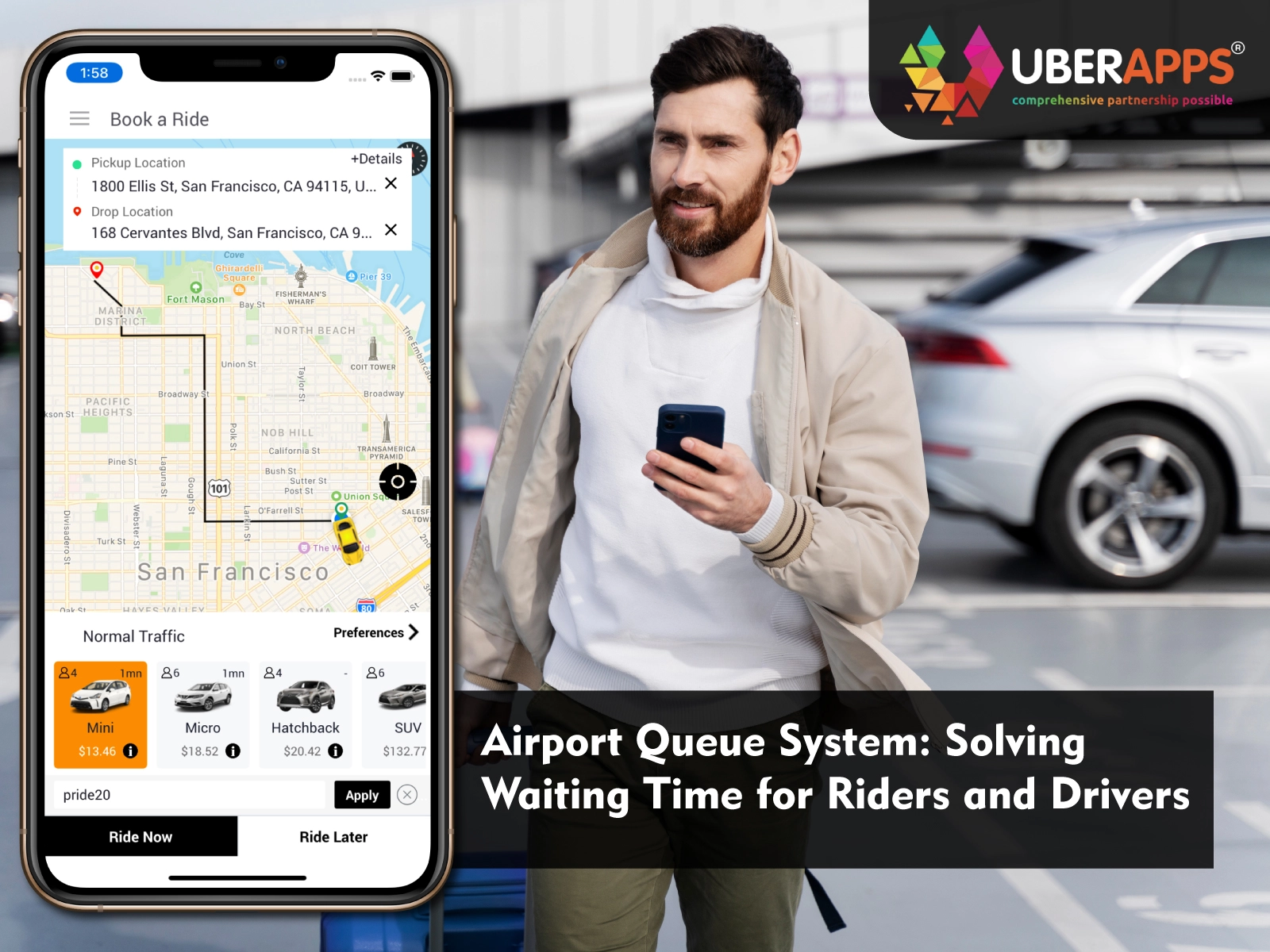
Airport Queue System: Solving Waiting Time for Riders and Drivers
Airport pickups have long been a pain point for both drivers and riders in the taxi and e-hailing industry. Long queues, chaotic passenger rushes, and inefficient dispatching often lead to lost earnings, frustrated drivers, and poor rider experiences. Enter the airport queue system—a smart innovation integrated into modern taxi booking apps that ensures fairness, efficiency, and reduced waiting times.
By leveraging GPS, geofencing, and automated queue algorithms, this system ensures that drivers are dispatched in order of arrival and riders are matched seamlessly without manual intervention.
In this blog, we’ll explore how the airport queue system is revolutionizing ride-hailing operations, why it’s essential for scalable Uber clone solutions, and how it’s shaping the future of airport mobility.
The airport queue system revolutionizes taxi booking apps by solving waiting-time inefficiencies for riders and drivers. It uses GPS, geofencing, and automated algorithms to queue drivers fairly and assign rides seamlessly. Passengers experience faster pickups, while drivers enjoy reduced idle time and predictable earnings. Airport authorities also benefit from lower congestion and better operational visibility. Grepix Infotech offers smart Uber clone and taxi app solutions with integrated airport queue management, real-time analytics, and in-app payment systems. By combining IoT, AI, and geofencing, these systems ensure transparency, fairness, and scalability. The result? Faster rides, happier passengers, and a future-ready mobility ecosystem.
Understanding the Airport Queue System in Taxi Booking Apps
What Is an Airport Queue System?
An airport queue system is a digital mechanism that organizes drivers waiting for ride requests at airports. Instead of relying on chaotic first-come, first-served methods, the system uses real-time GPS tracking and virtual queuing to assign rides fairly.
How It Works
- Drivers enter a designated airport geofence zone.
- The system places them in a virtual queue based on arrival time.
- When a ride request originates from the airport, it is automatically assigned to the driver at the top of the queue.
- Once the driver completes the trip, the system resets their queue position accordingly.
Key takeaway: The airport queue system ensures fairness, efficiency, and transparency for both drivers and passengers.
Why Airports Need Smart Ride-Hailing Queue Systems
Managing High Passenger Volumes Efficiently
Airports witness thousands of passengers every hour. Without structured management, ride requests become chaotic. IoT-enabled airport queue systems manage this traffic efficiently by automatically distributing ride requests based on driver location and queue position.
- Smoother passenger pickups.
- Minimal congestion at arrival terminals.
- Enhanced coordination between fleets and airport authorities.
Reducing Idle Time for Drivers
Idle time is costly for drivers. Without a queue system, drivers may circle around airports, wasting fuel and time. Airport queue algorithms reduce idle time by ensuring drivers wait in sequence, eliminating unnecessary driving or competition.
Key takeaway: Less waiting equals higher productivity and earnings.
Improving Passenger Experience
A well-implemented queue system in taxi apps ensures riders get connected quickly to the nearest available drivers. Passengers experience shorter wait times, predictable fares, and improved satisfaction levels.
Key takeaway: When the queue is managed digitally, riders feel safer and better served.
Core Features of an Airport Queue System in Taxi App Development
Virtual Queuing and Automated Assignment
Instead of drivers manually queuing, the system tracks their entry time into the airport zone using GPS and automatically queues them.
System Highlights
- FIFO (First In, First Out) logic for fairness.
- GPS-based geofencing to detect zone entry and exit.
- Re-entry protection to prevent queue manipulation.
Key takeaway: Automation ensures consistency and eliminates driver disputes.
Dynamic Geofencing and Location Intelligence
Modern taxi booking apps use dynamic geofencing a GPS-based perimeter around the airport.
How It Benefits Operations
- Ensures only authorized drivers join the queue.
- Prevents system misuse by restricting movement outside allowed zones.
- Alerts fleet managers if drivers exit the area prematurely.
Key takeaway: Geofencing keeps the queue accurate and compliant with airport regulations.
Real-Time Driver Notifications
Drivers receive in-app notifications on queue position, estimated waiting time, and ride allocation updates.
Examples of Alerts
- “You are 3rd in the queue.”
- “A ride request from Terminal 1 is assigned.”
- “Exit geofence to avoid queue reset.”
Key takeaway: Real-time communication ensures drivers remain informed and ready to serve.
Integration with Rider App and Admin Panel
A robust airport queue system integrates seamlessly into the rider app and admin dashboard, providing transparency across all user roles.
Admin Benefits
- Live queue monitoring and reports.
- Zone-based analytics for operational optimization.
- Automatic penalty for queue violations.
Key takeaway: Centralized visibility helps manage multiple airports or high-traffic zones effortlessly.
The Technology Behind Airport Queue Systems
GPS and IoT Integration
The system relies heavily on GPS accuracy and IoT devices embedded in the driver’s smartphone or vehicle telematics. These technologies detect entry and exit within the airport’s defined geofence in real-time.
Technologies Used
- Google Maps or OpenStreetMap APIs.
- Cloud-based GPS servers.
- Real-time data synchronization via MQTT or Firebase.
Key takeaway: Reliable GPS tracking is the backbone of a fair and responsive queue system.
AI-Based Dispatch Optimization
Artificial Intelligence (AI) plays a major role in smart dispatch systems. It predicts rider demand peaks and adjusts queue management dynamically.
Example Scenarios
- During flight arrivals, the system prepares extra drivers in the queue.
- AI reorders queues during low demand to ensure balanced ride distribution.
Key takeaway: AI-driven dispatch minimizes downtime and maximizes fleet efficiency.
Cloud and Database Architecture
The entire queue logic operates on a cloud-based backend, ensuring scalability and low latency.
- Queue data is stored and updated in milliseconds.
- Failover systems prevent data loss during high traffic.
Key takeaway: Cloud integration ensures the system scales easily as airports grow.
Benefits of Airport Queue Systems for Taxi App Stakeholders
For Drivers
- Fair dispatching ensures transparency.
- Reduced idle time and fuel costs.
- Predictable earnings through efficient trip allocation.
Key takeaway: Drivers focus on trips, not competition.
For Riders
- Quick ride assignments with minimal waiting.
- Seamless pickups from correct terminals.
- Consistent pricing and faster drop-offs.
Key takeaway: Better queue systems improve trust and convenience for passengers.
For Airport Authorities
- Reduced traffic congestion near terminals.
- Better compliance with airport transport policies.
- Enhanced collaboration with local fleet operators.
Key takeaway: Airport management benefits from better flow control and rider satisfaction.
For Taxi Businesses
- Real-time analytics for queue performance.
- Enhanced brand reputation through service reliability.
- Lower operational cost per trip.
Key takeaway: A smart queue system boosts ROI and service quality simultaneously.
How Airport Queue Systems Enhance Uber Clone and White-Label Taxi Apps
Uberapps’s Uber Clone Integration
At Uberapps, our Uber clone app solutions come with integrated airport queue modules. These tools manage driver placement, demand forecasting, and live notifications all within a single ecosystem.
Key Uber Clone Features with Airport Queue
- Intelligent dispatch linked to airport zones.
- Driver waiting time analytics and earning optimization.
- Multi-terminal queue handling (T1, T2, T3).
Key takeaway: Uberapps’s Uber clone app enables startups and fleets to deliver superior airport ride management.
White-Label Flexibility
The queue system is customizable for various business models—from airport shuttle services to corporate fleets. You can adjust queue length, geofence size, and priority logic to suit different airports or regulations.
Key takeaway: White-label apps with airport queue support ensure adaptability across global markets.
Airport Queue System and In-App Payment Integration
Seamless Digital Payments
When integrated with in-app payments for taxi apps, airport queue systems ensure riders pay instantly after completing the ride—reducing disputes and delays.
Payment Gateway Options
- Stripe, Paystack, and Razorpay integrations.
- Wallet top-ups for frequent airport commuters.
- Multi-currency and regional tax handling.
Key takeaway: Smart queue + smart payment = frictionless airport mobility.
Driver Incentives and Reward Automation
Drivers completing airport trips can automatically receive incentives or bonuses. For instance, completing five airport rides may unlock a “Priority Queue Pass” or extra commission credit.
Key takeaway: Automated rewards keep drivers motivated during high-traffic hours.
Real-World Example How Airport Queues Work in Uber & Lyft
Uber’s Airport Queue Model
Uber uses virtual queuing at airports to maintain fairness. Drivers entering the zone are automatically queued, and ride requests are distributed sequentially. If a driver cancels or leaves the zone, they lose their position.
Lyft’s Approach
Lyft uses time-based queue reentry, allowing drivers who just completed an airport drop to rejoin the queue faster, reducing downtime.
Key takeaway: Global ride-hailing leaders rely on automated queuing to enhance operational fairness.
Challenges in Implementing Airport Queue Systems
GPS Accuracy Issues
Weak GPS signals near terminals or multi-level parking structures can cause queue misalignment. This can be mitigated using advanced RTK GPS correction or Wi-Fi triangulation.
Driver Misuse and Compliance
Some drivers may attempt to manipulate queues by toggling their availability or exiting/re-entering the zone. Modern queue systems prevent this using re-entry cooldown timers and AI pattern detection.
Scalability and Airport Permissions
Integrating with airport authorities requires formal approvals and API access. Taxi businesses should ensure compliance with local transport and aviation regulations.
Key takeaway: Proper governance and tech refinement are crucial for successful queue deployment.
Future Trends in Airport Queue Management
AI and Predictive Queue Optimization
Next-gen systems will predict passenger demand based on flight schedules and weather data, pre-positioning drivers accordingly.
EV Integration
Electric vehicle (EV) fleets will sync with queue systems for charging station availability and battery optimization during wait times.
Blockchain for Transparency
Blockchain-backed queue logs can verify driver order, preventing disputes and increasing trust between fleet owners and drivers.
Key takeaway: The future of airport queues is autonomous, transparent, and eco-smart.
Why Choose Uberapps for Airport Queue Taxi App Development
Expertise in Scalable Ride-Hailing Solutions
Uberapps offers end-to-end taxi app development that includes airport queue systems, smart dispatch, and driver analytics.
Why Uberapps Leads the Market
- Proven expertise across 30+ global e-hailing deployments.
- AI-powered dispatch and geofencing systems.
- Scalable APIs for airports and enterprise fleets.
Key takeaway: Uberapps builds intelligent queue systems that redefine how airports manage mobility.
Conclusion
The airport queue system is more than a technical feature—it’s a transformative element of modern mobility. By streamlining ride allocation, reducing waiting time, and ensuring fair driver rotation, it enhances the experience for every stakeholder in the e-hailing ecosystem. From passengers catching late-night flights to drivers seeking fair opportunities, the queue system brings structure, fairness, and efficiency to one of the busiest transport hubs in the world.
As taxi app development continues to evolve, integrating such intelligent modules is crucial for business scalability and customer retention. Uberapps continues to innovate in this space, offering white-label Uber clone solutions that combine smart dispatch, in-app payments, and airport queue intelligence. The future of airport ride-hailing is connected, data-driven, and frictionless—and the airport queue system is leading the way there.
1. What is an airport queue system in taxi apps?
It’s a GPS-enabled virtual queue that assigns ride requests to drivers in order of arrival within the airport zone.
2. How does it reduce waiting time for drivers?
By eliminating manual lineups and ensuring rides are automatically assigned to the next driver in queue.
3. Can airport queues work in Uber clone apps?
Yes. Grepix Infotech integrates airport queue modules in its white-label taxi apps for airports worldwide.
4. Does the system need airport approval?
Most airports require compliance with their transport policies before enabling geofencing or queue integration.
5. What technologies power airport queue systems?
GPS tracking, cloud computing, AI dispatching, and geofencing APIs ensure real-time precision and reliability.
Author's Bio

Vinay Jain is the Founder of UBERApps and brings over 10 years of entrepreneurial experience. His focus revolves around software & business development and customer satisfaction.

